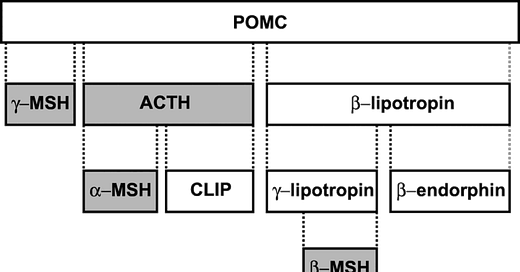TLDR - MSH is a lab marker tracked closely in CIRS patients. You don’t have low MSH because you have CIRS. You have CIRS because you are not following the foundations. Your light signaling is disrupted and this is causing you to have low MSH.
What is POMC?
Proopiomelanocortin (POMC) is a precursor protein composed of 241 amino acids, produced and processed in various tissues of the human body. POMC itself does not have a specific biological function, but it does serves as the source for several bioactive peptides, such as MSH, ACT), and others.
Light Signaling and the Modern Light Problem
UVA Light: Stimulates the production of peptides like Beta-Endorphin, Lipotropin, and Alpha-MSH (a form of MSH involved in regulating appetite, energy homeostasis, and sexual activity). Many people avoid sunlight and use sunglasses, reducing their exposure to UVA light necessary for MSH production.
Blue Light: Stimulates the production of ACTH and CLIP (involved in cortisol production and neurological function, respectively). The over use of screens and artificial lighting has led to constant exposure to blue light, which overstimulates ACTH and CLIP pathways, resulting in excess cortisol production and disrupted circadian rhythms.
Low MSH and CIRS
MSH and MARCoNS: MSH helps prevent the growth of MARCoNS. Low levels allow MARCoNS to thrive, exacerbating CIRS symptoms.
Inflammation and Immune Dysfunction: MSH plays a role in regulating the immune response and inflammation. Insufficient MSH can lead to uncontrolled inflammation and a poorly regulated immune response.
How MSH Production Specifically Works
UV Light Activation: UV rays from sunlight activate melanocortin 1 receptors (MC1R) in the skin.
Signal to Hypothalamus: Activated MC1R receptors send signals to the hypothalamus, indicating the presence of sunlight.
Hypothalamic Response: The hypothalamus releases neuropeptides, such as POMC.
Transport to Pituitary Gland: These neuropeptides travel to the anterior pituitary gland, stimulating corticotrophs.
Stimulation of MSH Production: ACTH, derived from POMC, stimulates corticotrophs to produce MSH.
Release and Action of MSH: MSH is released into the bloodstream, acting on melanocytes to produce melanin and providing some protection against UV radiation.




